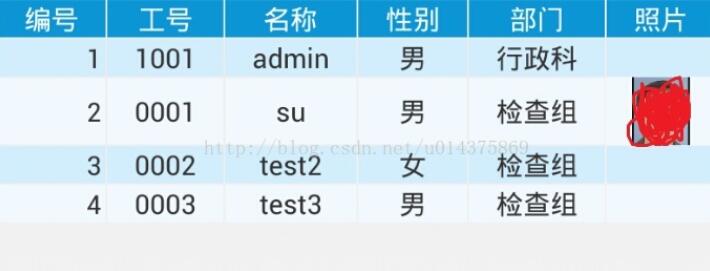жӮЁеҘҪпјҢзҷ»еҪ•еҗҺжүҚиғҪдёӢи®ўеҚ•е“ҰпјҒ
иҝҷзҜҮж–Үз« дё»иҰҒд»Ӣз»ҚAndroidеҰӮдҪ•дҪҝз”Ёд»Јз ҒеҠЁжҖҒз”ҹжҲҗз•ҢйқўпјҢж–Үдёӯд»Ӣз»Қзҡ„йқһеёёиҜҰз»ҶпјҢе…·жңүдёҖе®ҡзҡ„еҸӮиҖғд»·еҖјпјҢж„ҹе…ҙи¶Јзҡ„е°Ҹдјҷдјҙ们дёҖе®ҡиҰҒзңӢе®ҢпјҒ
жҲ‘们жңҖеёёз”ЁдҪҝз”ЁXMLжқҘзј–еҶҷAndroidеә”з”ЁзЁӢеәҸзҡ„UIпјҢиҝҷж ·зҡ„еҘҪеӨ„жҳҜж–№дҫҝеҝ«жҚ·еҸҜи§ҶеҢ–пјҢиҖҢдё”з»ҙжҠӨе’Ңдҝ®ж”№зү№еҲ«е®№жҳ“пјҢдҪҶжҳҜе®ғжҳҜйқҷжҖҒзҡ„гҖӮеҰӮжһңжҲ‘们иҰҒеҒҡзҡ„зЁӢеәҸзҡ„з•ҢйқўжҳҜеӣәе®ҡзҡ„пјҢз”ЁXMLеӣә然жҳҜжңҖеҘҪзҡ„йҖүжӢ©пјҢдҪҶжҳҜеҰӮжһңжҲ‘们йңҖиҰҒеҠЁжҖҒгҖҒзҒөжҙ»ең°жҺ§еҲ¶UIпјҢдҪҝз”Ёд»Јз ҒжқҘеҠЁжҖҒз”ҹжҲҗUIж— з–‘дҪҝжңҖеҘҪзҡ„еҠһжі•гҖӮ
еңЁXMLдёӯпјҢжҲ‘们дҪҝз”Ёзҡ„дә”еӨ§еёғеұҖпјҡLinearLayoutпјҲзәҝжҖ§еёғеұҖпјүгҖҒRelativeLayoutпјҲзӣёеҜ№еёғеұҖпјүгҖҒTableLayoutпјҲиЎЁж јеёғеұҖпјүгҖҒAbsoluteLayoutпјҲз»қеҜ№еёғеұҖпјүе’ҢFrameLayoutпјҲеё§еёғеұҖпјүеңЁAndroidдёӯд№ҹжңүеҜ№еә”зҡ„зұ»жқҘиЎЁзӨәгҖӮ
дёҫдёӘдҫӢеӯҗпјҢжҲ‘зҺ°еңЁйңҖиҰҒжҳҫзӨәдёҖдёӘиЎЁж јпјҢиЎЁж јзҡ„иЎҢж•°е’ҢеҲ—ж•°еҸҠе…¶еҶ…е®№йғҪдёҚзЎ®е®ҡпјҢеҰӮжһңеңЁXMLдёӯпјҢиҝҷжҳҜдёҚеҸҜиғҪе®һзҺ°зҡ„гҖӮ
е…Ҳз»ҷеӨ§е®¶зңӢдёҖдёӢжҲҗе“ҒпјҡпјҲдёӢйқўзҡ„д»Јз ҒеҸӘз»ҷеӨ§е®¶еұ•зӨәеҰӮдҪ•е®һзҺ°пјҢиЎЁж јйҮҢйқўзҡ„еҶ…е®№еҝҪз•Ҙпјү

йҰ–е…ҲпјҢж–°е»әдёҖдёӘдёҚеёҰд»»дҪ•жҺ§д»¶зҡ„XMLж–Ү件
<?xml version="1.0" encoding="utf-8"?> <LinearLayout xmlns:android="http://schemas.android.com/apk/res/android" android:layout_width="match_parent" android:layout_height="match_parent" android:orientation="vertical" > <TableLayout android:id="@+id/tableLayout" android:layout_width="match_parent" android:layout_height="wrap_content" > </TableLayout> </LinearLayout>
еңЁд»Јз Ғдёӯж–°е»әдёҖдёӘTableLayoutпјҡ
// TODO жҳҫзӨәиЎЁж јдҝЎжҒҜ
private void displayRegeditedInfo()
{
Iterator
iterator = iterable.iterator();
ICells
iCells = GlobalVariable.manager
.createPersonDataCells(IInspectionManager.CS_PERSON_LIST_CELLS);
boolean flag = true;// ж Үйўҳж ҸдёәtrueпјҢеҶ…е®№ж ҸдҪҚfalse
int colorChange = 1;// з”ЁжқҘеҲӨж–ӯеҚ•еҸҢиЎҢпјҢд»ҘжҳҫзӨәдёҚеҗҢзҡ„йўңиүІ
TableLayout tableLayout = (TableLayout) findViewById(R.id.tableLayout);
tableLayout.setStretchAllColumns(true);
tableLayout.setShrinkAllColumns(true);
while (iterator.hasNext())
{
// иЎҢзҡ„ж ·ејҸ
TableRow.LayoutParams params = new TableRow.LayoutParams(
ViewGroup.LayoutParams.WRAP_CONTENT, ViewGroup.LayoutParams.MATCH_PARENT);
if (flag)// йҰ–е…ҲжҳҫзӨәиЎЁж јзҡ„ж Үйўҳж ҸпјҢеҶ…е®№иҮӘе·ұе®ҡд№ү
{
TableRow titleRow = new TableRow(this);
for (int i = 0; i < colums; i++)// еҲ—ж•°
{// еҲ—еҗҚ
params.setMargins(1, 1, 1, 1);
TextView textView = new TextView(this);
textView
.setBackgroundColor(getResources().getColor(R.color.top));
textView.setTextColor(Color.WHITE);
textView.setTextSize(31);
textView.setLayoutParams(params);
textView.setText(columsName);// еҲ—еҗҚ
textView.setTextSize(30);
textView.setGravity(Gravity.CENTER_HORIZONTAL);
titleRow.addView(textView);// жҠҠжҺ§д»¶ж·»еҠ еҲ°иЎҢTableRowдёӯ
}
flag = false;
tableLayout.addView(titleRow);// жҠҠиЎҢж·»еҠ еҲ°TableLayoutдёӯ
}
// ж–°е»әдёҖиЎҢпјҢжҳҫзӨәжҜҸдёӘжҲҗе‘ҳзҡ„е…·дҪ“дҝЎжҒҜ
TableRow personRow = new TableRow(this);
for (int i = 0; i < lines; i++)
{
params.setMargins(1, 1, 1, 1);
object; // жҲ‘еңЁиҝҷйҮҢз”ЁObjectд»ЈиЎЁиЎЁж јжҳҫзӨәзҡ„еҶ…е®№пјҢ
// ObjectеҸҜд»ҘжҳҜеӯ—з¬ҰдёІгҖҒж•°еӯ—пјҢд№ҹеҸҜд»ҘжҳҜз…§зүҮпјҢзңӢдҪ е…·дҪ“зҡ„е®ҡд№ү
if (object instanceof String)
{// еӯ—з¬ҰдёІеұ…дёӯжҳҫзӨә
TextView textView = new TextView(this);
textView.setLayoutParams(params);
textView.setTextSize(29);
if (colorChange % 2 == 1)
textView.setBackgroundColor(getResources().getColor(
R.color.second));
else
textView.setBackgroundColor(getResources().getColor(
R.color.third));
textView.setText(object.toString());
textView.setTextSize(30);
textView.setGravity(Gravity.CENTER);
personRow.addView(textView);
}
else if (object instanceof Number)
{// ж•°еӯ—еұ…еҸіжҳҫзӨә
TextView textView = new TextView(this);
textView.setPadding(0, 0, 5, 0);// еҸіеҶ…иҫ№и·қ
textView.setLayoutParams(params);
textView.setText(object.toString());
textView.setTextSize(30);
textView.setTextSize(29);
if (colorChange % 2 == 1)
textView.setBackgroundColor(getResources().getColor(
R.color.second));
else
textView.setBackgroundColor(getResources().getColor(
R.color.third));
textView.setGravity(Gravity.CENTER_VERTICAL | Gravity.RIGHT);
personRow.addView(textView);
}
else if (object instanceof byte[])
{// жҳҫзӨәеӨҙеғҸ
TableRow.LayoutParams params2 = new TableRow.LayoutParams(60, 75);
ImageView imageView = new ImageView(this);
if (colorChange % 2 == 1)
imageView.setBackgroundColor(getResources().getColor(
R.color.second));
else
imageView.setBackgroundColor(getResources().getColor(
R.color.third));
Bitmap bitmap = BitmapFactory.decodeByteArray((byte[]) object,
0, ((byte[]) object).length);
imageView.setImageBitmap(bitmap);
imageView.setLayoutParams(params2);
personRow.addView(imageView);
}
else
{// з©әеҖј
TextView textView = new TextView(this);
textView.setLayoutParams(params);
textView.setTextSize(30);
if (colorChange % 2 == 1)
textView.setBackgroundColor(getResources().getColor(
R.color.second));
else
textView.setBackgroundColor(getResources().getColor(
R.color.third));
personRow.addView(textView);
}
}
colorChange++;
tableLayout.addView(personRow);
}
}иҝҳеҸҜд»ҘеҜ№ж•ҙдёӘеёғеұҖгҖҒж•ҙиЎҢжҲ–жҹҗдёӘз©әй—ҙж·»еҠ зӣ‘еҗ¬дәӢ件пјҢеҸӘйңҖsetId(int id)пјҢ然еҗҺеңЁи®ҫз«Ӣзӣ‘еҗ¬еҷЁеҚіеҸҜгҖӮ
д»ҘдёҠжҳҜвҖңAndroidеҰӮдҪ•дҪҝз”Ёд»Јз ҒеҠЁжҖҒз”ҹжҲҗз•ҢйқўвҖқиҝҷзҜҮж–Үз« зҡ„жүҖжңүеҶ…е®№пјҢж„ҹи°ўеҗ„дҪҚзҡ„йҳ…иҜ»пјҒеёҢжңӣеҲҶдә«зҡ„еҶ…е®№еҜ№еӨ§е®¶жңүеё®еҠ©пјҢжӣҙеӨҡзӣёе…ізҹҘиҜҶпјҢж¬ўиҝҺе…іжіЁдәҝйҖҹдә‘иЎҢдёҡиө„и®Ҝйў‘йҒ“пјҒ
е…ҚиҙЈеЈ°жҳҺпјҡжң¬з«ҷеҸ‘еёғзҡ„еҶ…е®№пјҲеӣҫзүҮгҖҒи§Ҷйў‘е’Ңж–Үеӯ—пјүд»ҘеҺҹеҲӣгҖҒиҪ¬иҪҪе’ҢеҲҶдә«дёәдё»пјҢж–Үз« и§ӮзӮ№дёҚд»ЈиЎЁжң¬зҪ‘з«ҷз«ӢеңәпјҢеҰӮжһңж¶үеҸҠдҫөжқғиҜ·иҒ”зі»з«ҷй•ҝйӮ®з®ұпјҡis@yisu.comиҝӣиЎҢдёҫжҠҘпјҢ并жҸҗдҫӣзӣёе…іиҜҒжҚ®пјҢдёҖз»ҸжҹҘе®һпјҢе°Ҷз«ӢеҲ»еҲ йҷӨж¶үе«ҢдҫөжқғеҶ…е®№гҖӮ
жӮЁеҘҪпјҢзҷ»еҪ•еҗҺжүҚиғҪдёӢи®ўеҚ•е“ҰпјҒ